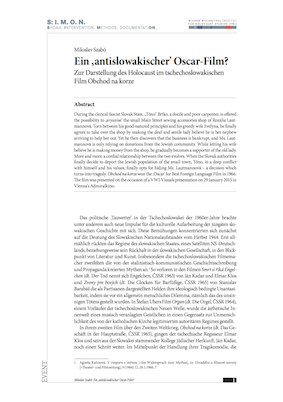 The fate of the European Roma during the Holocaust, the murder of several hundreds of thousands of Roma and Sinti in the territories under control of the Third Reich – a genocide which by Roma and Sinti representatives is also referred to as 'Porrajimos' or 'Samusdripen' – now forms an accepted part of European historical discourse on the 20th century and has become the focal point of a new Europe-wide process of Roma identity formation. In its monstrosity and unprecedented brutality it is like a vast shadow cast upon the common history of Roma and Gadje alike, a memento of an unspeakably dehumanised past.
The fate of the European Roma during the Holocaust, the murder of several hundreds of thousands of Roma and Sinti in the territories under control of the Third Reich – a genocide which by Roma and Sinti representatives is also referred to as 'Porrajimos' or 'Samusdripen' – now forms an accepted part of European historical discourse on the 20th century and has become the focal point of a new Europe-wide process of Roma identity formation. In its monstrosity and unprecedented brutality it is like a vast shadow cast upon the common history of Roma and Gadje alike, a memento of an unspeakably dehumanised past.
Historians have reconstructed the events that culminated in these murderous acts in great detail, mapping the increasingly radical acts of marginalisation and persecution of people labelled as 'Zigeuner' ('Gypsies') by the authorities. This marginalisation started during the Romantic period, when Europeans were told to see 'Gypsies' as fundamentally different and exotic – the 'last savages of Europe'. This, combined with the emerging 'science' of eugenics, which declared these differences to be genetically determined and therefore immutable, prepared the ground for their marginalisation and exclusion from society, based on pseudoscientific concepts.
A severe social crisis caused by the global economic crisis of the 1930s, aggravated by the lack of adequate social welfare systems in Central and Eastern Europe at the time, led to clashes between the Roma and non-Roma populations, especially in the formerly Hungarian, now Austrian, Burgenland region. This later provided the justification for the Nazi administration's racist policies against Roma and Sinti, which eventually culminated in genocide. Some key ingredients in this catastrophe may seem strangely familiar now, as we can again encounter them in Europe today. Looking at the policies that paved the way for the Nazi genocide of the 'Gypsies', it becomes clear that many of today's policies and administrative practices affecting Roma, especially in Eastern Europe, are not that new after all and have worrying echoes in the past.










